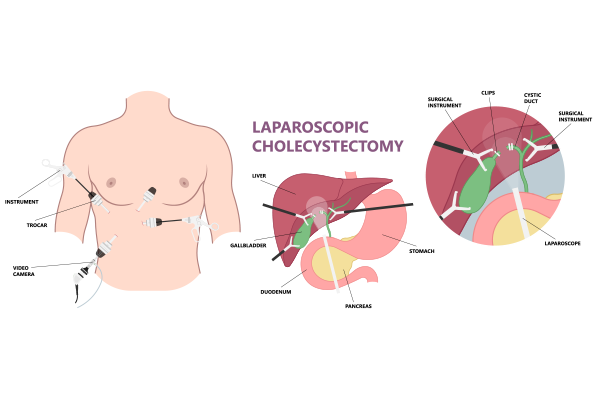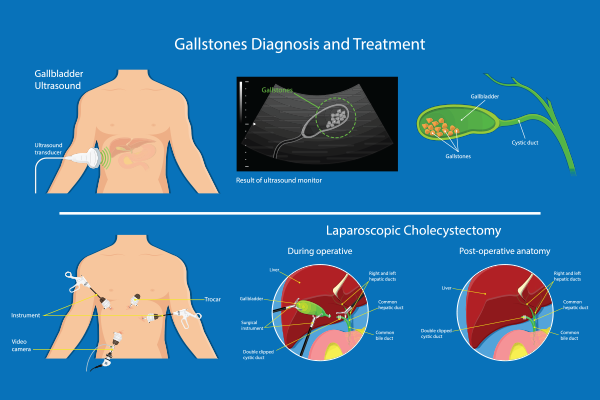.png)
Cholecystectomy is a common surgical procedure performed to remove the gallbladder. This blog aims to educate patients and their families about the procedure, its necessity, the surgical process, recovery, and post-operative care. At Manipal Hospital, we prioritize patient education to ensure you are well-informed and comfortable with your healthcare decisions.
Synopsis
What is Cholecystectomy?
The cholecystectomy procedure is the surgical removal of the gallbladder, a small organ located beneath the liver. The gallbladder stores bile, a digestive fluid produced by the liver. This procedure is typically recommended for patients suffering from gallstones, gallbladder inflammation, or other gallbladder-related issues.
Why is Gallbladder removal surgery Necessary?
-
Gallstones: Hardened deposits of digestive fluid that can cause severe pain and block the bile ducts.
-
Cholecystitis: Inflammation of the gallbladder, often due to gallstones.
-
Pancreatitis: Inflammation of the pancreas, which can be caused by gallstones.
-
Gallbladder Polyps: Growths that may become cancerous.
-
Biliary Dyskinesia: Poor functioning of the gallbladder.
Types of Cholecystectomy

-
Laparoscopic Cholecystectomy: A minimally invasive procedure where small incisions are made, and a laparoscope is used for gallbladder removal. This method is preferred due to its shorter recovery time and reduced risk of complications.
-
Open Cholecystectomy: A traditional surgery involving a larger incision in the abdomen. This method is used when laparoscopic surgery is not feasible.
The Gallbladder Operation Process
-
Preoperative Preparation: Patients undergo a series of tests, including blood tests, imaging studies, and a physical examination. Fasting is required for several hours before the surgery.
-
Anaesthesia: General anaesthesia is administered to ensure the patient is asleep and pain-free during the procedure.
-
Surgery:
-
Laparoscopic Procedure: The surgeon makes small incisions and inflates the abdomen with gas to provide a clear view. The surgeon inserts a laparoscope and surgical instruments to remove the gallbladder.
-
Open: A larger incision is made below the ribs on the right side, and the gallbladder is removed through this incision.
-
-
Postoperative Care: Patients are monitored in the recovery room until the effects of anaesthesia wear off. Pain management and antibiotics may be administered.
Recovery and Postoperative Care
-
Hospital Stay: Laparoscopic patients may go home the same day or after an overnight stay. Open gallstones surgery patients may require a longer hospital stay.
-
Pain Management: Pain is managed with prescribed medications. It’s normal to experience some discomfort at the incision sites.
-
Diet: Initially, a liquid diet is recommended, gradually progressing to solid foods. Patients are advised to avoid fatty and spicy foods.
-
Activity: Light activities can be resumed within a few days, but strenuous activities should be avoided for several weeks.
-
Follow-Up: Regular follow-up appointments are essential to monitor recovery and address any concerns.

Potential Risks and Complications
-
Infection: Though rare, infections can occur at the incision sites or internally.
-
Bleeding: Some bleeding is expected, but excessive bleeding may require medical attention.
-
Bile Leakage: Leakage of bile into the abdomen can occur, requiring additional treatment.
-
Injury to Nearby Structures: Rarely, nearby organs such as the bile ducts, liver, or intestines may be injured during surgery.
Life After Cholecystectomy
Most patients lead a normal life without a gallbladder. The liver continues to produce bile, which flows directly into the small intestine. Some dietary adjustments may be necessary to manage digestion, particularly in the initial weeks following surgery.
Dietary Adjustments Post-Surgery
-
Small, Frequent Meals: Eating smaller, more frequent meals can help manage digestion and prevent discomfort.
-
Low-Fat Diet: Since the gallbladder is no longer there to store bile, a low-fat diet can help reduce digestive issues.
-
Hydration: Staying well-hydrated is crucial for overall health and can aid in digestion.
-
Gradual Reintroduction of Foods: Gradually reintroducing different types of foods can help identify any that may cause discomfort.
| Category | Tips |
| Pain Management |
|
| Wound Care |
|
| Diet |
|
| Activity Levels |
|
| Follow-Up Care |
|
| General Tips |
|
Long-Term Health Considerations
-
Regular Check-Ups: Regular medical check-ups can help monitor your overall health and address any long-term effects of the surgery.
-
Healthy Lifestyle: Maintaining a healthy lifestyle, including a balanced diet and regular exercise, can promote overall well-being.
-
Awareness of Symptoms: Being aware of any new or unusual symptoms and reporting them to your healthcare provider is important for ongoing health management.
Conclusion
Cholecystectomy is a safe and effective procedure for treating gallbladder-related issues. At Manipal Hospital, our experienced surgical team is dedicated to providing the highest quality care and ensuring a smooth recovery for our patients. If you have any questions or concerns about cholecystectomy, please do not hesitate to contact our Bariatric surgeon. We are here to support you every step of the way.
FAQ's
Common symptoms include severe abdominal pain, nausea, vomiting, and jaundice.
The surgery typically takes about 1 to 2 hours, depending on the complexity of the case.
Yes, most people live a normal life without a gallbladder, though some dietary adjustments may be necessary.
It is advisable to avoid fatty, greasy, and spicy foods initially after surgery.
Most patients can return to light work within a week, but it may take several weeks to resume strenuous activities.





















 5 Min Read
5 Min Read














